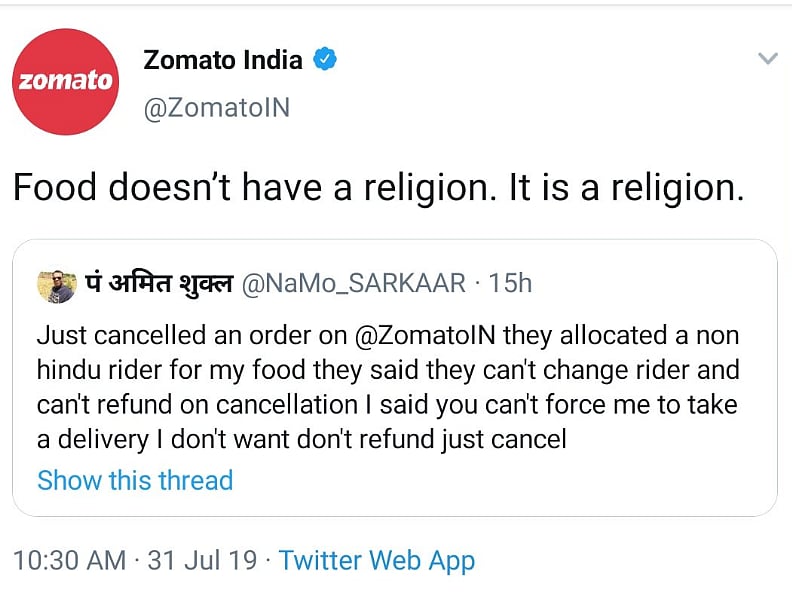Zomato controversy and what it says about news media ceding space to ‘social media’ events
What was an instance of bigotry was also a demonstration of idiocy.
It’s the middle of the week and you already have a social media post triggering outrage, if not a slugfest, and finding its place in the news cycle. In fact, it’s making front-page headline in some newspapers—not unusual for a large section of the news media that has struck a goldmine of useful idiots in social media to rescue it on dull news days.

In being registered as a news item, such posts and the cycle of responses they entail are now—to rephrase Habermas—part of the chronicled public sphere. There can be arguments about the merits and context of the food delivery company’s response. It’s already happening on the platform where it originated.
However, in times when label-sticking is the new digital blood sport, there is a strong case for the coverage of the exchange between the customer and the food delivery company being justified as an act of exposing online bigotry. That’s a point where the balance of power in mainstream media voices count because what was an instance of bigotry was also a demonstration of idiocy. That’s why they are useful idiots for media houses keen on organising panel discussions or publishing long op-eds on social media “events” of a type: the kind which suits their editorial inclinations and newsroom slants.
In times when social media has become the key forum for instant public conversation, its impact on the news cycle shouldn’t be surprising. However, what’s important here are ways in which it’s defining the very idea of an event. There is an increasing number of news stories in the mainstream media that could properly be called social media events. With the rapid Internet penetration in India and gradual bridging of the digital divide, what one is witnessing in the last few years is the role of agenda-setting being disproportionately shepherded by social media events.
This shift is not small and seems a second wave after a different reorientation was seen in the 1990s.
As I wrote in a previous piece in 2017, social media platforms are currently a challenge to TV and new media, in the same way TV media gave competition to print in the late 1990s and the first decade of this century. This was a phase in the news industry when newspapers were grappling with giving exclusive TV stories front-page coverage because the stories had hooked the nation round-the-clock the previous day.
Back in 2017, I referred to the inflection point of August 2006. This was when television news carried a live telecast of an operation to rescue a five-year-old boy, Prince, from an abandoned borewell in a village in Haryana. It was a story that wouldn’t have merited more than a box item in newspapers of pre-television days. But the way it became a talking point throughout the day forced papers to have it on page one the next morning.
Sociologist Shiv Viswanathan had described it as page one-and-half story for print—socially dramatic enough to be Page 1 and trivial enough to be Page 3, so caught somewhere in between. That’s a form of agenda setting that Indian newspapers have learnt to live with. Now social media is forcing the same not only on print, but also on television and digital media.
A glance at the front pages of major newspapers of last few days can give enough clues on how news agenda was defined by an “outrageous” statement or even a video found in social media space. Writing five years ago, political scientist Pratap Bhanu Mehta had warned against the dangers of such facile spells of self-congratulation: “As critics, we often define our identities by picking out the worst arguments and the worst characters to go after. This is not because of the magnitude of the objective threats they pose. It is because our intellectual victories are easy.”
One may add two more components to it, especially in the context of social media adding to the amorphous nature of public sphere.
First, it has witnessed the empowerment of a new breed of nuisance-powerholders and as well as nuisance-powerbrokers on social media sites like Twitter. If the sudden democratisation of rabble-rousing has seen a generation of brash provocateurs, it has been complemented by an enabling force of their powerful defenders. The latter often decide who is going to be heard more on the platform.
Second, it has paved the way for an equally vocal—if not more—online army thriving on virtue-signalling. Having support systems in the influential upholders of the institutionalised “common sense” (imposed from above), they are anxious to be seen riding the high horse of “good taste”. It’s their naivete and disconnect that make their otherwise powerfully networked presence on social media a plot for regular online skirmishes.
What, however, is more important is that in conceding a sizeable chunk of its turf to social media generated news “events”, mainstream media news cycles and discourse is prone to a fallacy that netizens are already trapped in: the blurring of lines between the private and public spheres of articulation, concerns and issues. The price that nuisance-powered content creators for social media sites, with news outlets being a proxy setting, are going to pay is gradual depletion of individuality. The cost that “public sphere” is going to incur is the loss of a sense of entirety amid islands adrift.
